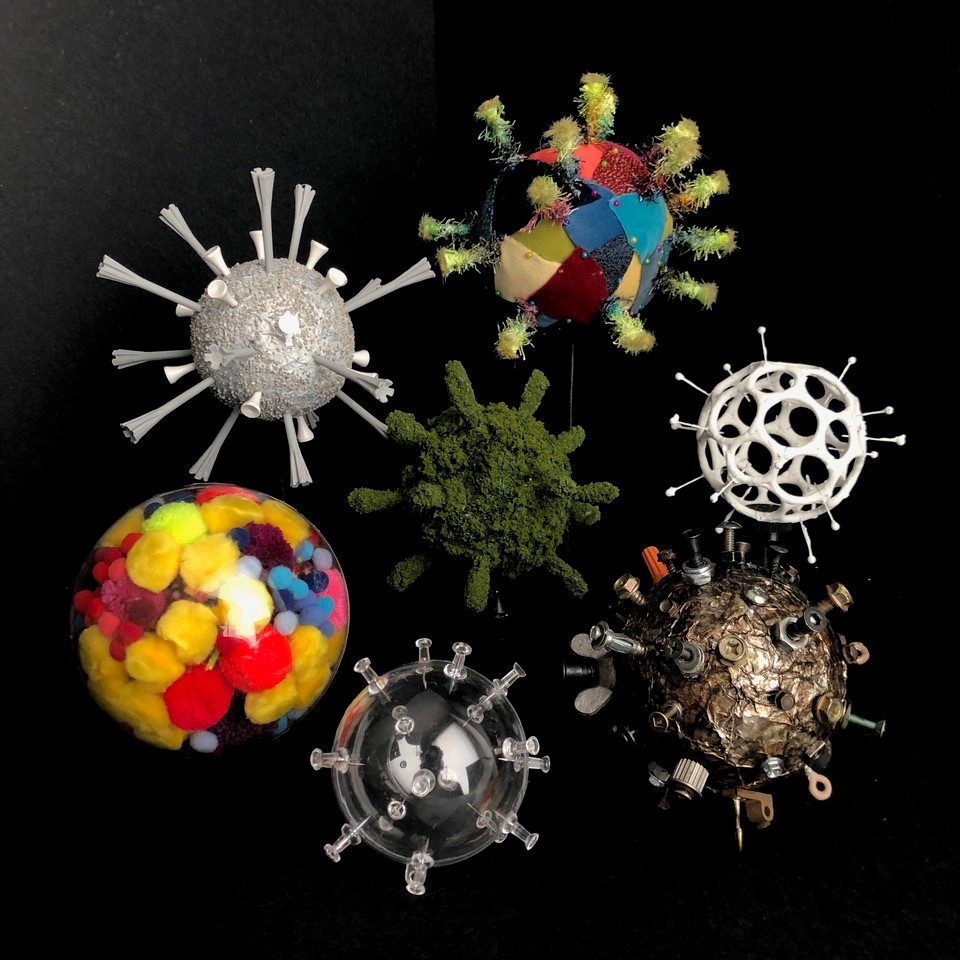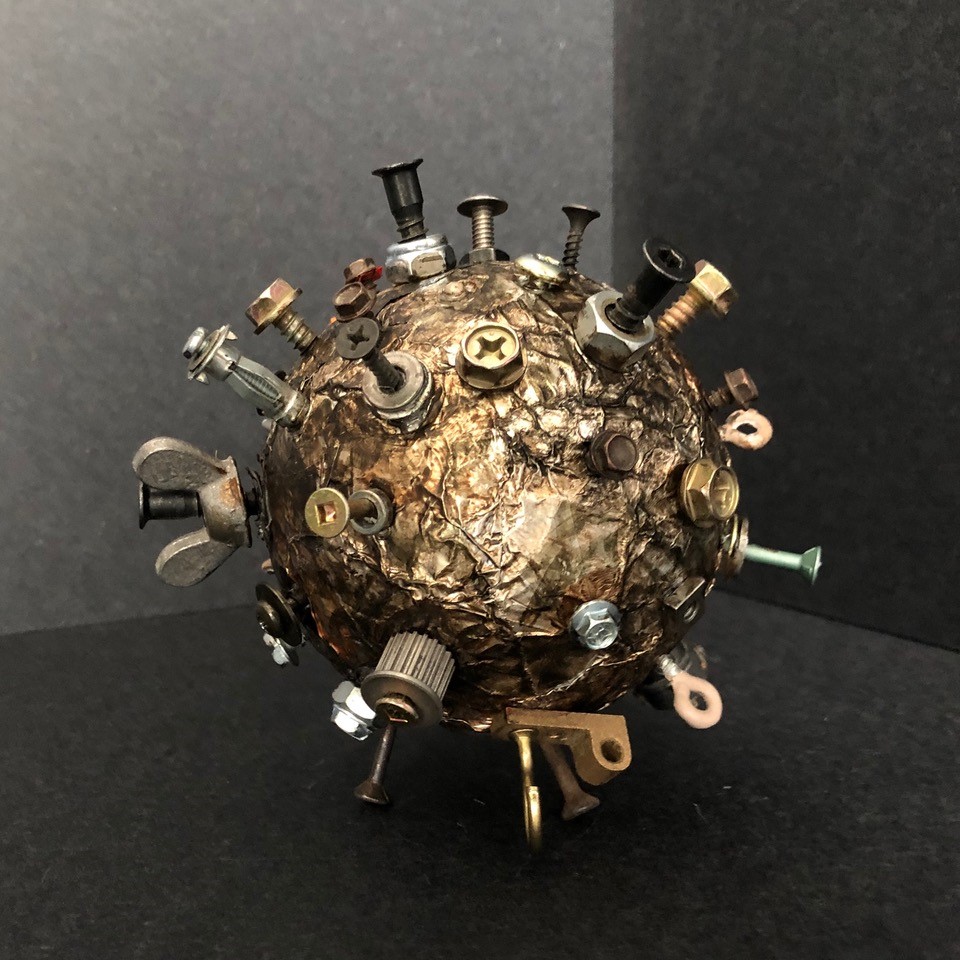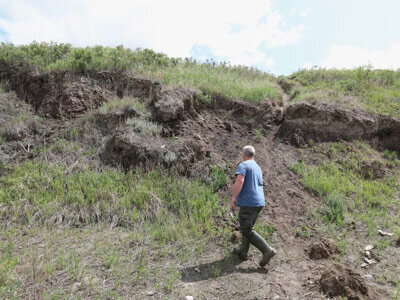
USask students create coronavirus sculptures in online art class
ART 141 offered through remote learning due to the global COVID-19 pandemic
By Shannon Boklaschuk
2020 hasn’t been a typical year, and ART 141 hasn’t been a typical art class.
Due to the global COVID-19 pandemic, the course—like many offered during the fall term at the University of Saskatchewan (USask)—moved online to help prevent the spread of the coronavirus. While it’s unusual for studio art classes to be offered through remote learning, Prof. Susan Shantz and her students made the best of it.

Shantz, a faculty member in the Department of Art and Art History in USask’s College of Arts and Science, adapted the foundational sculpture course for remote delivery by posting her lectures online. She also tasked her students with creating coronavirus-inspired sculptures at home using found materials.
USask student Keitha McClocklin was up for the challenge.
“There are endless possibilities of things that can be made from paper, cardboard and found objects from our living spaces and the dollar store, as we learned in this class,” said McClocklin, who is pursuing a Bachelor of Fine Arts degree in the College of Arts and Science. “Despite working from home with no access to the sculpture studio, we realized our imagination is the only limit to what we can make with the most basic of materials. I loved the tactile nature of working with all the materials, including paper, cardboard and plaster.
“Every aspect of our lives right now is affected by the global coronavirus pandemic, and it seems fitting to make art about the virus and this crazy era,” she added.
McClocklin created a series of seven virus-inspired sculptures made out of different materials—including Styrofoam, transparent plastic balls, pom poms, push pins, sewing pins, a baby teething ball, tinfoil, model train foliage, rocks, golf tees, Q-tips, fabric scraps, dishcloth yarn, ink and acrylic paint—using several of the principles and elements of design the students learned about in the class: repetition, variety, scale, texture, form and colour. She also created what she calls a “mock black cube gallery” in which to photograph her sculptures.
“My initial concept was to place them in glass or plastic cases—vitrines—so they would appear like anthropological historical artifacts in a natural history museum, but this concept wasn’t feasible due to the difficulty of accessing glass enclosures. Instead, I mounted several viruses on posts and photographed them in a group,” she said. “The scale is ambiguous; this is intentional and is one of the benefits to building a mock gallery space.”

ART 141 proved to be a learning experience for Shantz as well, as she had never taught the sculpture course remotely before. Before the pandemic, she was accustomed to seeing her students in person in the classroom and in the sculpture studio on the USask campus.
Shantz quickly recognized that her students were living in various places during Term 1, both in and outside of Saskatoon, and she also realized that not every student would have easy access to art supplies. As a result, she encouraged her students to create works of art using organic and inorganic materials they could find around their homes and yards.
Flexibility and innovation proved to be key to the students’ success. While the class typically used plaster in the past, Shantz acknowledged that not everybody would have the ability to work with dusty plaster in their homes and modified another assignment as a result.
“I gave them an alternative to try to work with modified versions of papier-mâché if they couldn’t do plaster—so there were some things like that,” said Shantz, who also completed the assignments herself. “I would try them out in the studio just to see if I could get the same goal of the project achieved with the change of materials. It’s worked out pretty well.”
While the move to remote learning presented some challenges, there were also some unforeseen positives. Since Shantz couldn’t view the students’ sculptures in person, the students were required to document their creations through photography—resulting in Shantz providing additional instruction on how to take good pictures of their work. Shantz now plans to increase her photography instruction even when the course returns to in-person instruction.

“This a good professional skill, when you think about lighting and how you can make a big gallery-looking space out of pieces of white paper or foam core,” she said.
ART 141 will be offered online again in Term 2, starting in January 2021. McClocklin said she encourages other students to take the course, whether it’s offered in person or online. She noted her professors in the Department of Art and Art History have adapted well to remote learning.
“The remote-learning experience, while not ideal, worked surprisingly well for this class. Professor Shantz masterfully adapted the curriculum for the online situation,” McClocklin said.
“The first thing she taught us was how to build a mock gallery space and how to photograph our sculptures in the space with the correct lighting, in order to best capture and share the three-dimensionality of our work digitally. She recorded videos and PowerPoint presentations for all the textbook material; she created projects that—despite using basic found objects and dollar-store items— were engaging and allowed full use of our creativity.
“I missed not being able to interact with other students as we worked on our projects but, overall, I feel like I did not miss out on any learning due to the class being online.”


